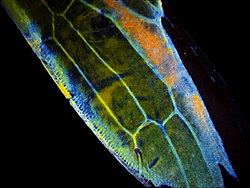Chitin

Chitin[1] is a semitransparent material that is the main component of the exoskeletons of arthropods, such as crustaceans (e.g. crab, lobster and shrimp) and insects (e.g. ants, beetles and butterflies), of the cell walls of fungi, the radula of molluscs and the beaks of cephalopods (e.g. squid, and octopuses). Chitin has also proven useful for several medical and industrial purposes.

Chitin Media
Structure of the chitin molecule, showing two of the N-acetylglucosamine units that repeat to form long chains in β-(1→4)-linkage.
Haworth projection of the chitin molecule.
A close-up of the wing of a leafhopper; the wing is composed of chitin.
Chemical configurations of the different monosaccharides (glucose and N-acetylglucosamine) and polysaccharides (chitin and cellulose) presented in Haworth projection
References
- ↑ (C8H13O5N)n (IPA: [ˈkaɪtn̩]) is a long-chain polymeric polysaccharide of beta-glucose that forms a hard, semitransparent material found throughout the natural world.
Other websites
- Chitin Product Information from China GreatVista Chemicals Archived 2006-06-20 at the Wayback Machine
- Horseshoe Crab Chitin Research Archived 2009-06-26 at the Wayback Machine




